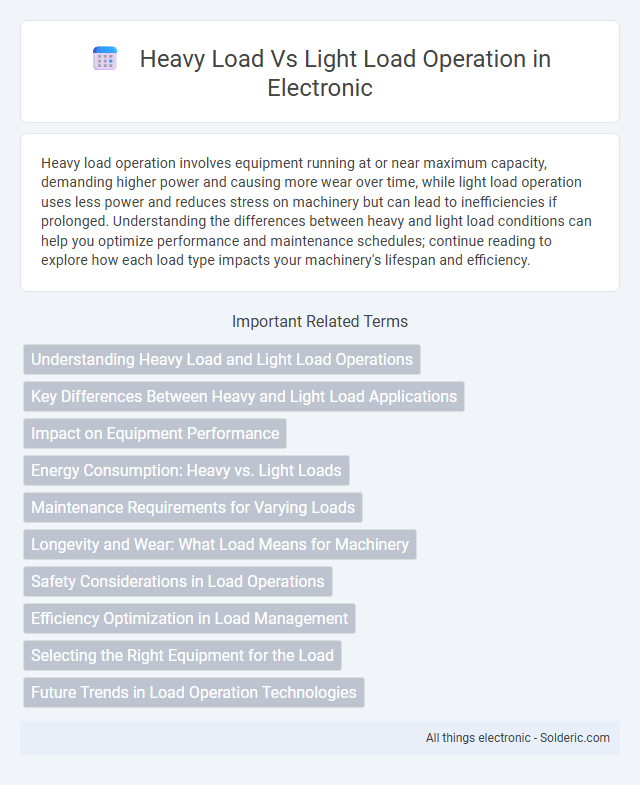Heavy load operation involves equipment running at or near maximum capacity, demanding higher power and causing more wear over time, while light load operation uses less power and reduces stress on machinery but can lead to inefficiencies if prolonged. Understanding the differences between heavy and light load conditions can help you optimize performance and maintenance schedules; continue reading to explore how each load type impacts your machinery's lifespan and efficiency.
Comparison Table
| Aspect | Heavy Load Operation | Light Load Operation |
|---|---|---|
| Load Intensity | High; maximum or near-maximum capacity | Low; minimal or partial capacity |
| Energy Consumption | High energy usage | Lower energy usage |
| Equipment Stress | Increased wear and tear | Reduced mechanical stress |
| Operational Speed | Typically slower due to load | Faster and more efficient |
| Risk of Failure | Higher risk due to strain | Lower risk, safer operation |
| Typical Applications | Industrial manufacturing, heavy machinery | Light assembly, testing, and maintenance |
Understanding Heavy Load and Light Load Operations
Heavy load operation refers to machinery or equipment operating near or at their maximum capacity, often requiring enhanced power and cooling systems to maintain efficiency and prevent overheating. Light load operation occurs when the equipment runs below its optimal capacity, which can lead to inefficient energy use and potential wear due to frequent cycling. Understanding the distinction between heavy and light load operations helps you optimize performance, reduce maintenance costs, and extend the lifespan of your machinery.
Key Differences Between Heavy and Light Load Applications
Heavy load applications involve handling high power, increased torque, and extended operating cycles, requiring robust machinery with reinforced components and advanced cooling systems. Light load operations focus on lower power demands, reduced wear, and higher efficiency, often using compact, lightweight equipment designed for frequent starts and stops. Understanding these key differences helps you select the appropriate equipment to optimize performance and longevity in your specific application.
Impact on Equipment Performance
Heavy load operation subjects equipment to increased mechanical stress and higher energy consumption, which can accelerate wear and reduce overall lifespan. Light load operation typically results in lower stress and less energy usage, enhancing efficiency but potentially causing issues like incomplete combustion or underutilization. Optimizing your equipment's load based on operational needs balances performance longevity and energy efficiency.
Energy Consumption: Heavy vs. Light Loads
Heavy load operation significantly increases energy consumption due to greater power demand and prolonged motor activity compared to light load operation, which requires less electrical input and results in lower overall energy use. Electric motors running under heavy loads often experience reduced efficiency and higher heat generation, leading to increased energy losses, whereas light loads optimize efficiency by maintaining lower current draw and minimizing thermal stress. Energy consumption metrics indicate that operating equipment at light loads can reduce electricity costs and extend machinery lifespan through improved energy efficiency and reduced wear.
Maintenance Requirements for Varying Loads
Heavy load operation demands more frequent maintenance due to increased wear on components such as bearings, gears, and hydraulic systems, which can lead to accelerated fatigue and potential failures. Light load operation typically results in lower maintenance frequency but may cause issues like inconsistent lubrication or buildup of contaminants due to less heat generation. You should tailor maintenance schedules to load conditions, monitor wear patterns carefully, and adjust lubrication and inspection intervals to optimize equipment longevity and performance.
Longevity and Wear: What Load Means for Machinery
Heavy load operation significantly accelerates wear and tear on machinery components, reducing overall longevity due to increased friction, heat, and mechanical stress. Light load operation minimizes these effects, promoting extended service life and more consistent performance by limiting strain on critical parts. Understanding load impact enables better maintenance scheduling and optimized machine usage to enhance durability.
Safety Considerations in Load Operations
Heavy load operations demand stringent safety measures to prevent equipment failure and ensure structural stability, as the risks of accidents and injuries escalate with increased weight. Light load operations, while generally less hazardous, still require careful adherence to safety protocols such as proper rigging and load securing to avoid unexpected shifts or drops. Your safety during any load operation depends on thorough planning, regular equipment inspections, and strict compliance with industry standards to mitigate potential hazards.
Efficiency Optimization in Load Management
Efficiency optimization in load management requires balancing heavy load and light load operations to maximize system performance and energy use. Heavy load operation delivers higher output but demands more power and generates excess heat, while light load operation conserves energy yet may reduce overall productivity if prolonged. You can optimize efficiency by calibrating equipment settings to match workload patterns, ensuring optimal energy consumption and minimizing operational costs.
Selecting the Right Equipment for the Load
Choosing the appropriate equipment for heavy load operations requires prioritizing machinery with high load capacities and reinforced structural components to ensure safety and efficiency. Light load operations benefit from lighter, more maneuverable equipment that maximizes operational speed and reduces fuel consumption. Matching the equipment specifications to the load weight and operational demands optimizes performance and minimizes wear and maintenance costs.
Future Trends in Load Operation Technologies
Future trends in load operation technologies emphasize the integration of AI-driven load management systems that optimize performance based on real-time data analytics, significantly improving efficiency for both heavy and light load operations. Advanced sensor networks and IoT devices enable precise monitoring, reducing wear and energy consumption, and extending equipment lifespan. Your operational capabilities will benefit from predictive maintenance algorithms that minimize downtime and tailor load handling to specific operational demands.
Heavy load vs Light load operation Infographic

 solderic.com
solderic.com